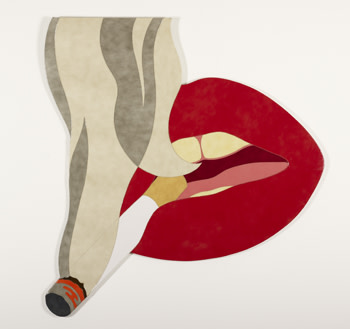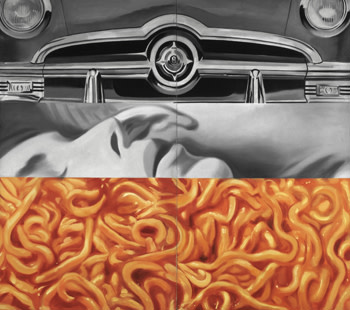How Pop Art plundered consumerist culture

Simply sign up to the Life & Arts myFT Digest -- delivered directly to your inbox.
The revelation in the 1990s that the CIA sponsored American abstract expressionism, that it flaunted the art of the drippers, the splashers and the colour-fielders as a commercial for capitalism, caused quite a stir. While communist bloc artists were squeezed into socialist realism – workers, factories, tractors, cornfields – the US avant-garde, serious and intense, was expressing itself on the floors of huge New York lofts.
The art movement that followed ab-ex, as it turned out, might well have done the CIA’s work for free. It was a ready-made commercial for consumerism that could have been called “capitalist realism”. But it became known as Pop Art. And Pop artists wanted to have their Coke and drink it. Here was art that was simultaneously in love with and critical of the ephemera of consumer culture.
When the Soviet Union agreed to hold a show of US products in Moscow in 1959, Russians were awed by the array of labour-saving devices and luxurious kitchens available to Americans. Hostesses distributed free lipsticks, infuriating the authorities. Those lipsticks, capitalist middle fingers in the crimson of the Soviet flag, could have served as an emblem for Pop Art, the ubiquitous pouting lips of sex translated into selling.
Indeed, at the Barbican’s enjoyable Pop Art Design show, a whole room is devoted to lips. There is, of course, the Lips Sofa (credited to Italian Studio 65, although first envisaged in Dalí’s brilliant portrait “Visage de Mae West”); Tom Wesselmann’s disembodied smoking lips; and Warhol’s Marilyn Monroe with the crudely painted pout. John Pasche’s Rolling Stones logo is surprisingly missing.
And finally there are Pauline Boty’s beautiful, under-regarded paintings. Boty, who died at 28, was at the centre of the swinging London scene. As a woman artist, she is a conspicuous exception here. Pop Art’s objectification of the female form is voluptuously visible in the show but whether this is tongue-in-cheek or just plain sexist is never clear. The lipsticks are phallic, the pout is provocative and, in Allen Jones’s lady-as-coffee-table, we have an unsettling image of domestic submission, the flipside of all those kitchen devices. But pop artists anonymised everyone, not just women – figures do not really feature here unless they were pre-objectified, such as Jones’s woman or Mick Jagger’s crotch on the cover of Sticky Fingers.
In a show ostensibly about Pop Art design, it is mostly art that is the star (Blake, Lichtenstein, Rauschenberg, Warhol et al). The problem is that while there certainly was a field of design influenced by it, Pop Art reworked the ready-made, the already familiar imagery of mass culture: ubiquitous brands, paparazzi photos and the visual language of advertising. The design that derives from it is an extension of those images.
Some designs acknowledge this Duchampian crossover – notably the Castiglioni brothers’ stool made from an appropriated tractor seat – but others do not. Impeccable (if overfamiliar) Charles and Ray Eames pieces, futuristic Finnish Eero Aarnio chairs and Peter and Alison Smithson’s laughably naff sub-B-movie house of the future all sit a little uneasily here.
The one place where the Pop Art/Pop Design premise truly gels is in the work of Richard Hamilton. Having worked as a graphic designer and taught design, Hamilton created what became a virtual Pop manifesto in “Just what is it that makes today’s homes so different, so appealing?” This 1956 collage seems to predict all the constituents of Pop – even down to the word itself on the label of the phallic lollipop held suggestively at waist height by the posing bodybuilder. Here is body fetishism, the promise of sex, consumerism, keeping-up-with-the-Joneses, the brands, the pulp fiction, the ads and the canned ham. The ceiling, meanwhile, is replaced by a looming moon, as space becomes attainable in a cold war rush to colonise the final frontier.

Hamilton was obsessed with design. Not the garish, sexualised images of mass culture that form the spine of this show, but the sleek technical perfection of the Ulm School. Emerging from a design school in southern Germany set up with Marshall Plan money, its rigorous modernism became a kind of postwar Bauhaus. The school’s most visible success was electrical manufacturer Braun (and its chief designer Dieter Rams). Hamilton’s “Toaster” (1967) is here, its modernist design depicted in silvered elevation, engineering realism made abstract, the object made art. The toaster sits, lonely and small, on the floor: minimalist modernism squashed by the scale and colour of Pop.
It is a telling moment. Pop Art is about making the banal into big art; design is about creating an image for the banal, so that it can be marketed.
Yet the design here actually seems less cynical than the art. The extravagant, futuristic forms are the result of new processes. Injection-moulded plastic furniture, PVC dresses and poured polyurethane armchairs indicate an optimistic belief in the possibilities of the future. The art, though, is an admission of defeat. How could anything better express contemporary life than supermarket shelves, photos of celebrities, and signs lining freeways?
Hamilton wrote a postcard to architect Peter Smithson in 1957, jotting notes on what he thought might be a new art. “Pop art,” he wrote, “is Popular (designed for a mass audience), Transient (short-term solution), Expendable (easily forgotten), Low Cost, Mass Produced, Young (aimed at youth), Wicked, Sexy, Gimmicky, Glamorous, Big Business.”
He was both right and wrong. Warhol became an industry, and Richard Prince, Takashi Murakami and Jeff Koons are in every oligarch’s collection. Pop is certainly big business. This show is sponsored by Vitra, a Swiss furniture company that made many of the original pieces in the exhibition. The Pop artists blurred the space between shop and museum. The exhibition’s creator, architectural agency AOC, has impeccably caught this blurring in a pastel-hued, subtly kitsch-infused set that blends Las Vegas, LA and Main Street, woven around the Barbican’s concrete columns. Hamilton was right about wickedness, sexiness, glamour and youth, but he was wrong about Pop Art ever being expendable or easily forgotten. Its ephemerality is, ironically, inscribed in our culture for ever.
——————————————-
‘Pop Art Design’, Barbican Art Gallery, London, to February 9, barbican.org.uk
Comments